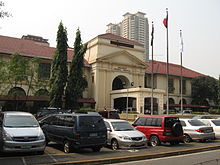Health in the Philippines
Access to healthcare services in the Philippines is marked by significant inequities, particularly affecting poor communities. These disparities are reflected in both access to services,[1] health outcomes, and the effects of climate change which exacerbate the incidences of infectious diseases.[2] One major challenge is the varying financing for local government units, leading to differences in the benefits packages of insurance plans and difficulties in accessing public health services.[3] The decentralization of healthcare responsibilities from the federal government to local governments has, in some cases, increased local authority but has also made certain communities vulnerable to a lack of access to basic services.[4]

In response to the Millennium Development Goals' focus on maternal and child health, the Philippines began the National Demographic and Health Survey in 1968 to assess the effectiveness of public health programs in the country.[5]
Barriers to healthcare
[edit]Poor communities suffer a higher burden of disease due to inequities in access to services and health status. Since financing for local government units often vary and the benefits package for insurance plans may be unfavorable, some communities face difficulties accessing public health services. Shifting the responsibility of healthcare from the federal government to the local governments has increased local authority and has made communities susceptible to lack of access to basic services.[6] In addition, most healthcare payments are made out of pocket, especially when receiving care from privately owned institutions. Barangay health stations serve as primary public health facilities and are staffed by doctors, nurses, midwives, and barangay health volunteers.[7]
There is no requirement in the Philippines for causes of death to be medically determined prior to registration of a death, so national statistics as to causes of death in the Philippines cannot be accurately substantiated. In the provinces, especially in places more remote from registries, births and deaths are often not recorded unless some family need arises, such as entry into college. When there is no legal process needed to pass on inheritance, the recording of deaths is viewed as unnecessary by the family.
Population
[edit]As of September 2020, the Philippines has a population of nearly 110 million and a population density of 368 per square kilometer. 32% of the population of the Philippines is under 15 years old, and only 22.2% is over 60. In the Philippines, 16.6% of the population lived below the national poverty line in 2018.[8][9]
Health indicators
[edit]
| Health Indicators | Male | Female | For Both Sex |
|---|---|---|---|
| Life expectancy at birth (Years) 2016 | 66.2 | 72.6 | |
| Under 5 mortality rate (Per 1,000 live births) | 28.4 | ||
| Maternal mortality rate (MMR) (Per 100,000 live births) | 121 | ||
| Neonatal mortality rate (Per 1,000 live births) | 13.5 |
Health problems in the Philippines
[edit]The Philippines faces a large burden of disease:

The main Non-Communicable Diseases are Diabetes, Heart disease, Stroke, Cancer, and Chronic diseases that affect the airways and lungs. While these diseases affect different parts of the body in different ways, they often share common origins.
Communicable diseases: Acute Respiratory Infection, Influenza A (H1N1), Bird Flu (Avian Influenza), Chickenpox, Cholera, Dengue, Diarrhea, Hand, Foot, and Mouth Disease, Hepatitis A, Hepatitis B, Hepatitis C, HIV/AIDS, Influenza, Leprosy, Malaria, Measles, Meningococcemia, Pertussis, Poliomyelitis, Rabies, Severe Acute Respiratory Syndrome (SARS), Sore Eyes, Tuberculosis, Typhoid Fever
Effects of climate change
[edit]Climate change, heavy rains, and increased temperatures are linked with the increased transmission of vector and waterborne diseases, such as malaria, dengue, and diarrhea (WHO). The heavy rains and increased temperatures lead to increased humidity which increases the chance of mosquito breeding and survival.[11] Increased natural disasters not only directly contribute to the loss of human life, but also indirectly through food insecurity and the destruction of health services.[11]
Increased disasters not only directly cause more human deaths, but also indirectly cause more deaths by destroying health services and causing food shortages. This disruptions may increase the spread of infectious disease, making recovery and health maintenance much more difficult for impacted communities.See also
[edit]- HIV/AIDS in the Philippines
- Smoking in the Philippines
- Water supply and sanitation in the Philippines
- Nutrition Foundation of the Philippines, Inc.
- National Nutrition Council (Philippines)
References
[edit]- ^ Capanzana, Mario V.; Aguila, Divorah V. "119 - 129: Philippines Case Study: Government Policies on Nutrition Education". Karger.
- ^ Davila, Federico (December 13, 2019). "Human ecology and food discourses in a smallholder agricultural system in Leyte, The Philippines". Agriculture and Human Values. 37 (3): 719–741. doi:10.1007/s10460-019-10007-6.
- ^ Silvestre, Maria Asuncion; Nuevo, Christian Edward; Ballesteros, Alfredo Jose C.; Bagas, Joy; Ulep, Valerie Gilbert (2023). "Identifying and Addressing the Determinants of Stunting in the First 1000 Days: Review of Nutrition Governance Strategies and Implementation of the Philippine Plan of Action for Nutrition (PPAN) 2017–2022". EconStor.
- ^ Viajar, Rowena V.; Dorado, Julieta B.; Rongavilla, Emily O.; Caraig, Georgina S.; Gulay, Joanne Jette S. (April 2022). "Monitoring the implementation of nutrition intervention at the local level". Evaluation and Program Planning. 91. doi:10.1016/j.evalprogplan.2022.102047.
- ^ "Philippines National Demographic and Health Survey 2013" (PDF).
- ^ Azfar, Omar; Gurgur, Tugrul (July 1, 2008). "Does corruption affect health outcomes in the Philippines?". Economics of Governance. 9 (3): 197–244. doi:10.1007/s10101-006-0031-y. ISSN 1435-6104.
- ^ Lakshminarayanan, Rama (May 2003). "Decentralisation and its implications for reproductive health: the Philippines experience". Reproductive Health Matters. 11 (21): 96–107. doi:10.1016/S0968-8080(03)02168-2. ISSN 0968-8080. PMID 12800707.
- ^ "Philippines Population (2020) - Worldometer". www.worldometers.info. Retrieved October 1, 2020.
- ^ "GHO | Key Country Indicators | Philippines - key indicators". WHO. Retrieved October 1, 2020.
- ^ "GHO | Key Country Indicators | Philippines - key indicators". WHO. Retrieved October 1, 2020.
- ^ a b "Climate Change Risk in the Philippines: Country Fact Sheet" (PDF). USAID. February 2017.
